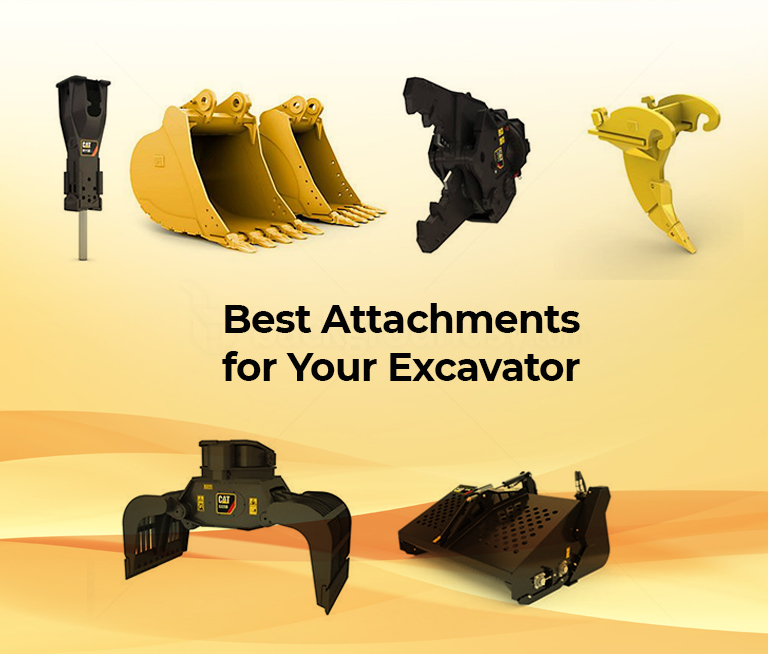Attachment to maximize Excavator Potential
Posted on: August 7, 2023
By : PRODUCTS & BRANDS

Excavators are powerful machines that play a vital role in construction, mining, and various other industries. These versatile machines are known for their ability to dig, lift, and move heavy materials with ease. However, the true potential of an excavator is only realized when equipped with the right attachments. These attachments enhance the machine's capabilities and enable it to perform a wide range of tasks efficiently.
In this blog, we will delve into the importance of attachments in maximizing excavator potential and explore some key attachments that can transform an excavator into a multi-functional powerhouse.
The Power of Attachments
Attachments are specialized tools that can be added to an excavator's arm, boom, or bucket to extend its functionality. They allow excavators to perform tasks beyond their primary digging and lifting functions. By utilizing the right attachments, operators can achieve increased productivity, reduced labor costs, and enhanced versatility on the job site.
- Buckets for Every Task: Buckets are the most common excavator attachments, available in various sizes and shapes to suit different tasks. General-purpose buckets are ideal for digging and lifting operations, while trenching buckets are designed for creating narrow trenches. Additionally, ditch cleaning buckets help in cleaning out ditches and grading surfaces. Choosing the appropriate bucket attachment for the task at hand maximizes efficiency and minimizes unnecessary wear and tear on the machine.
- Hydraulic Hammers: Hydraulic hammers, also known as rock breakers, are essential attachments for breaking down hard materials such as concrete, rocks, and asphalt. These attachments utilize the hydraulic power of the excavator to deliver powerful percussive blows, making them indispensable for demolition and construction projects.
- Grapples: Grapple attachments are designed to handle loose materials like debris, logs, and scrap metal. They come in various configurations such as fixed, rotating, or clamshell styles. Grapples enable the excavator to grasp and manipulate materials effectively, increasing efficiency in material handling tasks.
- Augers: When it comes to drilling holes for foundations, poles, or fences, auger attachments are invaluable. Augers are available in different diameters and can be used for various soil types. They streamline the drilling process and ensure precise hole placement, saving time and effort.
- Shears and Pulverizers: These attachments are tailored for cutting through steel beams, concrete, and other heavy materials. Shears are particularly useful in demolition projects, while pulverizers help break down materials into smaller particles, enhancing waste management efforts.
- Compactors: Compactor attachments enable excavators to compact soil, gravel, and other materials, creating a solid foundation for construction projects. This eliminates the need for separate compaction equipment, reducing costs and improving project timelines.
- Rippers: Rippers are designed to break up hard and compacted surfaces, such as frozen ground or asphalt. They are especially beneficial in excavation and site preparation tasks, where the ground needs to be loosened before further work can proceed.
- Tiltrotators: Tiltrotator attachments provide the excavator with a full range of motion, allowing the bucket to tilt and rotate. This enables operators to achieve precise digging angles and work more efficiently in tight spaces, reducing the need for repositioning the machine frequently.
Maximizing Efficiency and Productivity
Effective utilization of excavator attachments goes beyond just selecting the right tool for the job. It involves understanding the capabilities of the attachments and incorporating them into the overall workflow seamlessly. Here are some strategies to maximize efficiency and productivity through attachment usage:
- Operator Training: Well-trained operators who understand how to use different attachments effectively can significantly impact productivity. Providing training and guidance on attachment selection, operation, and maintenance ensures that the excavator is used to its full potential.
- Routine Maintenance: Regular maintenance of both the excavator and its attachments is crucial to ensure smooth operation and longevity. Proper lubrication, cleaning, and inspection help prevent breakdowns and downtime.
- Attachment Changeovers: Minimizing downtime during attachment changeovers is essential. Quick-coupler systems can expedite the process, allowing operators to switch attachments efficiently without wasting valuable time.
- Job Planning: Thorough job planning involves considering the tasks at hand and choosing the most appropriate attachments beforehand. This eliminates the need for frequent attachment changes and ensures a continuous workflow.
- Adapting to Site Conditions: Different job sites present varying challenges. Adapting attachment choices based on soil conditions, material types, and space constraints optimizes performance and prevents unnecessary strain on the equipment.
Conclusion
Attachments are the key to unlocking the full potential of excavators. With the right attachments, these machines can perform an array of tasks beyond traditional digging and lifting. From hammers that break rock to grapples that handle debris, each attachment adds a new layer of functionality to the excavator. By training operators, practicing regular maintenance, and planning jobs strategically, construction companies and contractors can ensure that their excavators are operating at peak efficiency and productivity. As technology continues to advance, it's exciting to imagine what new attachments will be developed to further enhance the capabilities of these versatile machines.